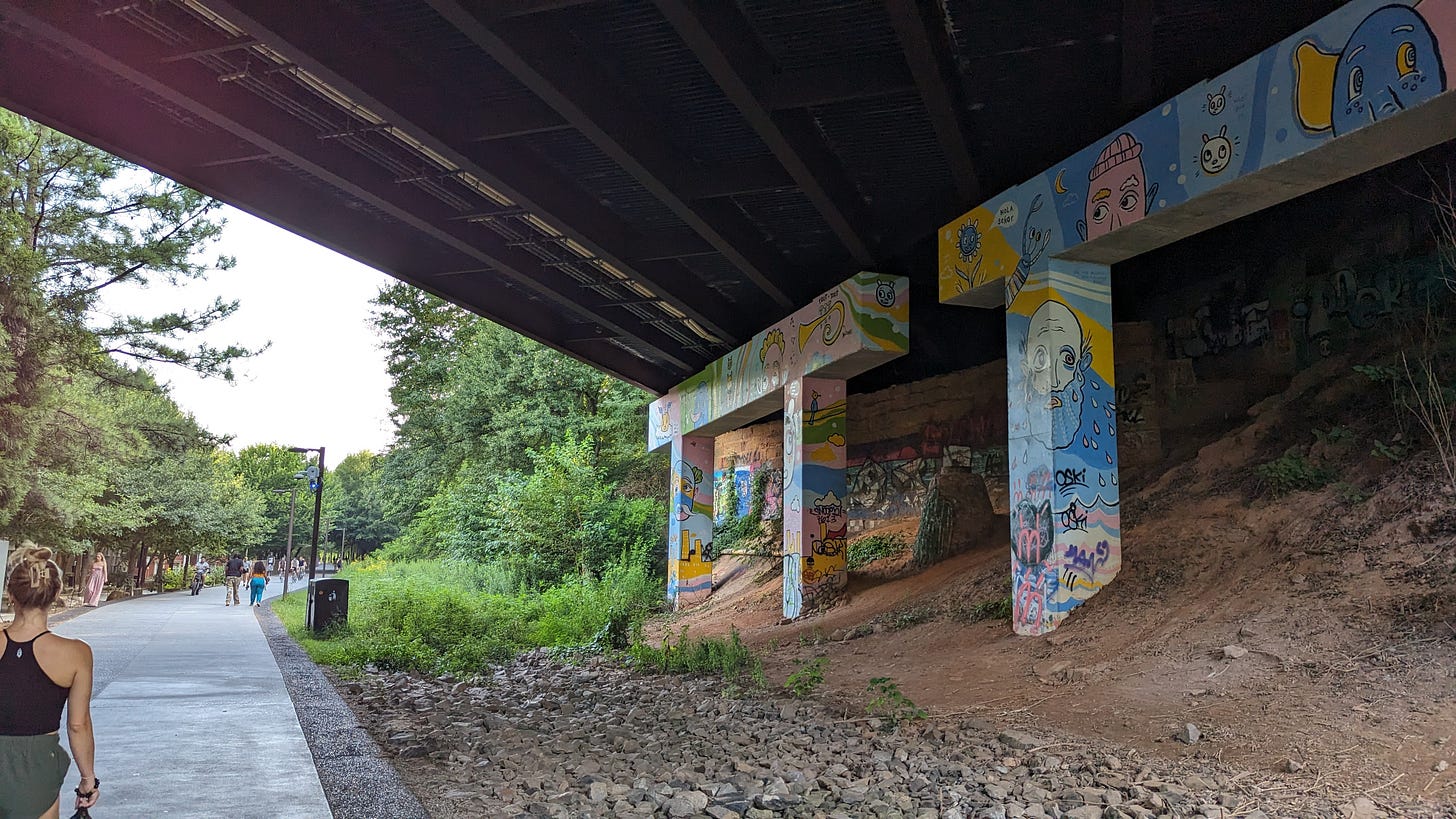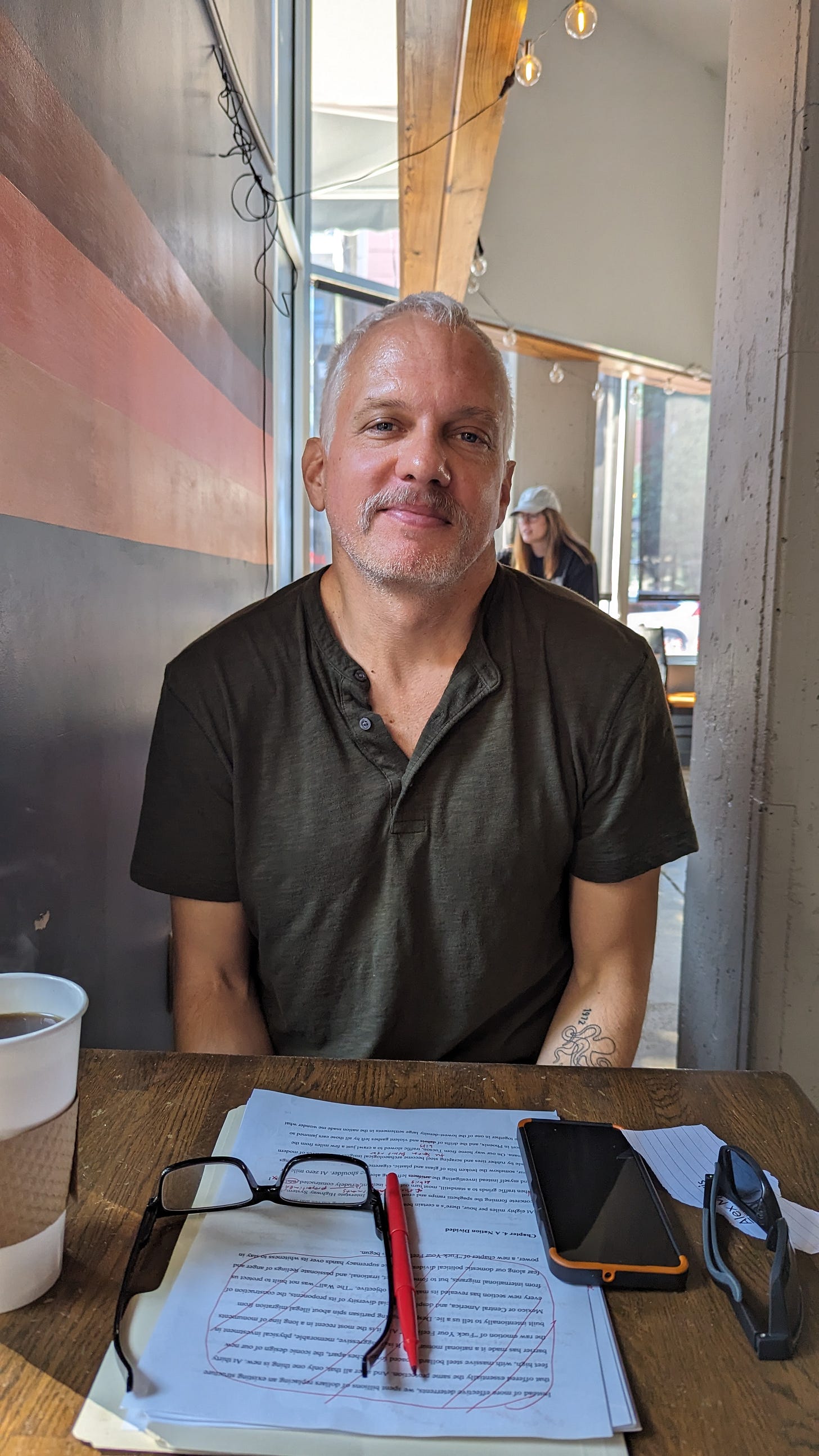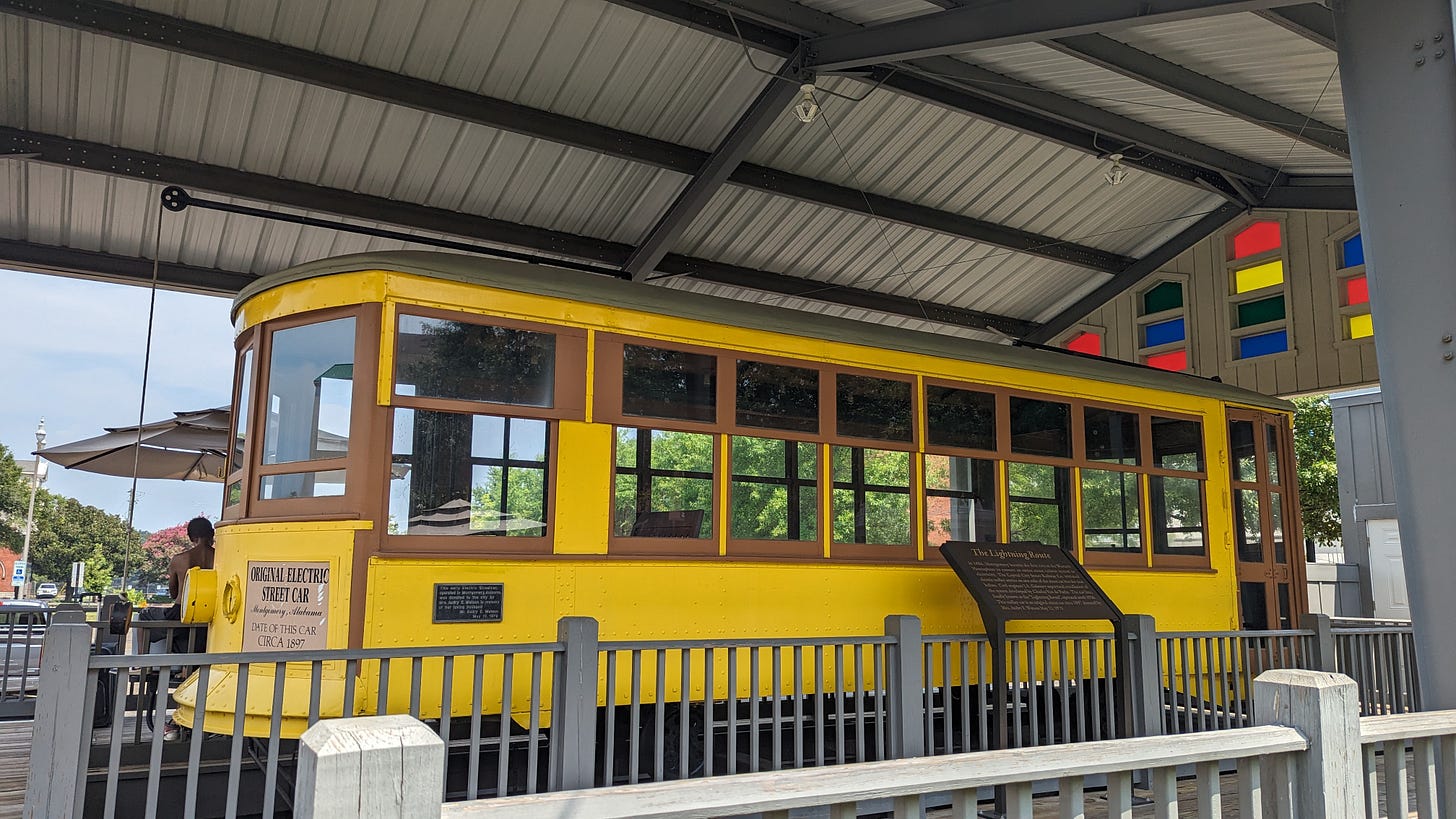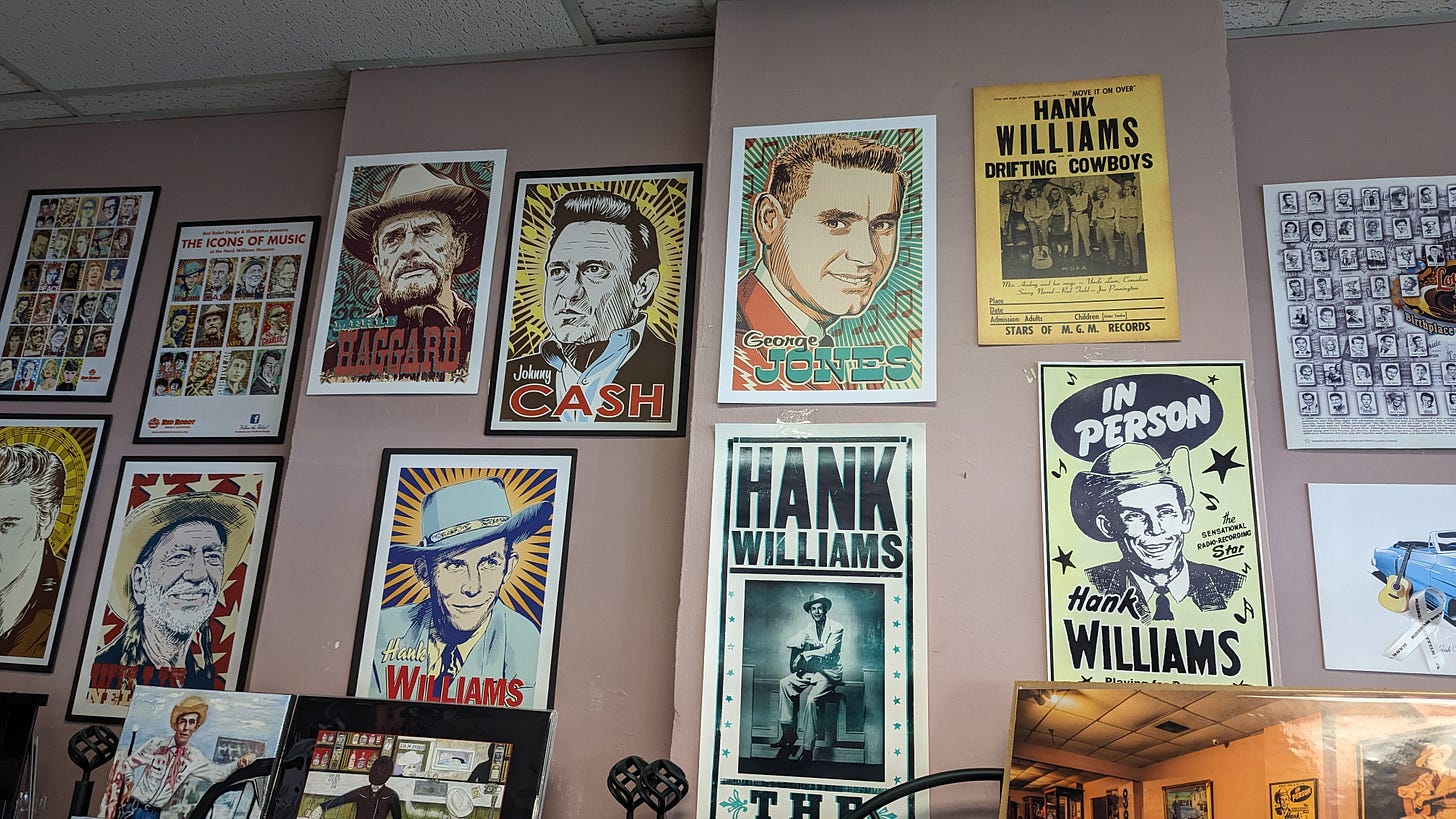Old South/New South, Atlanta and Montgomery
Civil rights, rails, trails, relics and country songs
Columbia, South Carolina
I was no longer riding Megabus, and the transit surprises continued. I was unexpectedly early for my bus from Columbia to Atlanta. They’d made the departure time 45 minutes later but failed to inform me. Annoying, but at least I hadn’t missed it. I was the only person at the station besides the staff. I found myself chatting to the station’s Operations Manager, Ted. Since 1992 Ted had been in the transportation industry, working for Greyhound and other bus companies. He currently works for Southeastern Stages, and he’s worked all over America and Canada. He spoke to me about how Southeastern Stages, Greyhound and Megabus are partnering more and more, which explains my uncertainty around which bus line I was taking.
He talked about how Greyhound’s ticketing system has improved in recent years, and now almost all ticket sales are online. I told him how so many people were scared for me to go on this bus trip. He hears this negative stereotype all the time too. He told me he and his staff are at the station from 6:30am until after midnight. They see everything, and he doesn’t know why the stigma is so bad.
I told him about my terrible circumstances waiting for the Greyhound in Asheville, and he said I should write about this problem because he’s heard about it, but he hasn’t personally observed it. He made the appeal for people to use Southeastern Stages, which tend to come with nice bus stations and helpful staff. Maybe I’ll come back and do a new Carolina bus trip, riding only with them.
Ted kindly gave me some peanuts and Gingerale, and I hopped on the bus to Atlanta. The ride was pretty and nonincidental. I sat by myself on this bus and everyone was relatively quiet.
Atlanta, Georgia
I was curious and apprehensive about the Atlanta Greyhound Station; I’d heard so many things and read quite a few horrific reviews. I got in and it was busy with all kinds of different people. It was almost 4pm, and I felt just as safe as I did everywhere else the bus stopped. My kind friend Erin was coming pick me up. Zach and I had met her in Buenos Aires last year, and she lives 10 minutes from the bus station. Erin also agreed to let me stay in her spare bedroom that evening, how generous!
I’m no stranger to Atlanta, my Aunt has lived near Alpharetta forever, and I would stay with her later on in the trip. Because I was leaving early in the morning for Montgomery, Alabama, it seemed like an easy (and fun) idea to stay with Erin. She and I hung out that night and talked about travel and our future. I interviewed her at Victory Sandwiches, located on the famous Beltline. From her I learned about an Atlanta controversy making national news, Cop City. This would not be the last time I heard about it. Listen to Erin’s interview below.
Erin and I walked and talked along the Beltline. The Beltline was once over 20 miles of rail corridors and it is now being reinvented as multi-use trails, reconnecting neighborhoods and historically divided communities. And that’s only the beginning.
The next morning Erin and I went to Inman Perk Coffee, and she pointed out a tall distinguished man who walked into the coffee shop after us. It was urban designer Ryan Gravel, the founder of the aforementioned beltline! I jumped up, recorder, notebook and phone in hand and approached him. He was there to work, but he gave me some of his time to talk about the beltline.
Ryan came up with the Atlanta Beltline in the late 90s, for his graduate thesis in architecture and city planning at Georgia Tech. Later he worked for an architecture firm and the people of the city fell in love with his vision. For years he worked as a volunteer to see the vision come to fruition, and they’re still working on it.
He described the Beltline as “a new kind of infrastructure and a new way a life.” He told me that the first half of the trail is complete, but the full trail will be finished in four or five years. Ultimately, a street car is in the vision that stops every half mile and connects people to the larger transit. The city has invested half a billion dollars in the Beltline, and so far they’ve seen over ten billion dollars of private sector investment as a result.
”The future of Atlanta is not what you see now, the future is coming,” he told me.
It was exciting to learn how one single idea has the power to change the entire direction of a city.
Erin then dropped me at the Greyhound station with relatively no drama. One man asked me if I wanted weed, but I did not. Because I was now back to riding Megabus rather than Greyhound, I waited for the bus next to the station rather than inside. This bus trip was fine, and it was the first time I got to ride in an actual Megabus branded vehicle. It was double decker, and I rode up top!
I was excited to stop in Montgomery in part due to an Alan Jackson song I loved listening to in my childhood, all about Alan visiting Hank Williams’ grave, “Midnight in Montgomery.”
Montgomery, Alabama
I got off the bus in Montgomery in early afternoon and stepped into sweltering heat, my backpack weighing into my shoulders. I had no contacts here and little knowledge of what to expect. All of my previous time spent in Alabama was simply driving through. In many ways, Montgomery is an important location when it comes to change in America. It was also the first city in the western hemisphere to make their street cars electric in 1886. They named the route the Lightening Route and I saw a nod to that; the original street car displayed was one of the first thing I noticed.
It was in Memphis while visiting the National Civil Rights Museum that I was reminded that Montgomery is the home of Rosa Parks and the famous bus boycott that ultimately led to desegregation of buses in the South. I was advised to visit the Legacy Museum in Montgomery; it was a five minute walk from the bus stop. The Lorraine Motel in Memphis where Dr. King was murdered is now the entrance and forms the beginning to The Civil Rights Museum. The Legacy Museum in Montgomery was once a slave warehouse, as Montgomery was the capital of domestic slave trade in the state.
Like the National Civil Rights Museum in Memphis, this museum was full on. Similar to the Memphis Museum, it focuses on the slave trade and takes us to the modern day. Also like certain parts of the Civil Rights Museum, you couldn’t take photos or videos. The Memphis Civil Rights Museum was established in 1984 and has since received over 20 million dollars to enhance it. The Legacy Museum opened in 2018 and also cost over 20 million to build. Both are incredibly compelling, depressing and informative. I was gutted that I couldn’t take photos in the Legacy Museum as there were so many interesting facts particularly about the Southern region of America. I was impressed by sculptures made by Ghanaian artist Kwame Akoto-Bamfo, whose work is dedicated to African lives lost at sea in the slave trade.
One visitor asked an attendant how to get out of the museum before she was even a quarter of the way through. “Had enough?” the attendant joked.
As you leave The Legacy Museum there’s a reflection room where you can sit and reflect on the horrors of humanity and the evil we’re capable of. I heard a visitor ask an attendant how she works here every day. “It’s not always easy,” the attendant said, “but you’ve got to have hope.”
When I see the evils my fellow Americans are capable of, I get depressed and not just because of what humans have done but also because of the ongoing suffering that happens globally at the hands of those in power. The Legacy Museum and the Civil Rights Museum do not gloss over anything. The Legacy Museum finishes by bringing the visitor to mass incarceration, where Americans still suffer, predominantly men, predominantly black men.
According to the 13th Amendment of the Constitution: "Neither slavery nor involuntary servitude, except as a punishment for crime whereof the party shall have been duly convicted, shall exist within the United States, or any place subject to their jurisdiction."
After the Legacy Museum, I went to the Rosa Parks Museum. This museum had a lower budget, but I found it more enjoyable as its ending is more definitive and positive. It does a great job explaining the year-long journey to public transportation integration that started when one woman refused to give up her seat on a bus. First she ignited Montgomery and then the nation. (It was not the first bus boycott, but it was the most successful.)
Afterwards and I interviewed museum workers Joe and Andres about what it was like living in Montgomery. Joe mentioned that after living in various bigger cities across America, he’s observed that people in smaller towns are more willing to talk to you. (Montgomery is the capital of Alabama with a population of 200,000.)
Both spoke about poverty in the South and how that is linked to lack of education and crime.
”Until the gap shortens between the haves and have-nots, there will continue to be a problem,” Joe said.
I asked them what they wished the rest of the world knew about the South, and Joe pointed out that he’s heard all kinds of negative opinions, but it’s not as bad as people think. People of every skin tone are tied in to each other at this stage in Alabama, and the racism isn’t as bad as people make it out to be.
”Portland Oregon, right now they’re having Aryan Nationalist Protests, we don’t have any of that here,” Joe told me.
(Here’s an interesting article on Oregon and white nationalism.)
”I wish people would know our history in Montgomery,” Andres told me. “This is where the civil rights movement was born. Montgomery is a very important historic city.”
”It’s kind of funny to think of it like this, as (Montgomery) was the capital of the confederacy and then it became the center of the civil rights movement in some ways, so it kinda did this whole flip. It took both side of the aisle playing nicely with each other,” Joe said.
I thanked the two for their time, and I set off to find my accommodation for the night.
Hanging out in Montgomery was strange. Like many other cities, there were giant sidewalks but no one seemed to be around. It felt eerily quiet. I had opted not to Uber and just trust my ability to walk, but it was really hard to gauge the safety.
I got into my Airbnb, another old fire station similar to the hostel where I spent my last night in Little Rock! I’d been inside for less than half an hour when I met an eccentric-and-entertaining artist named Jesse Dallas, who walked from the garage straight into my Airbnb (he had the code). He was setting up an art exhibition in the large communal garage space. Because I didn’t have a car, he hadn’t realized that I’d come in. I wandered around in the garage with him, listening to him talk to me about his paintings. He builds houses as well, and when he’s not in Alabama he lives in the Appalachian Mountains of North Carolina, so we shared a connection there. He was one of several people to speak to me about how Montgomery is changing due to the Equal Justine Initiative. (EJI built the Legacy Museum.)
Jesse said shocking things to me, but he did make me laugh. He commented on me not shaving my legs and gave me wild descriptors behind the meaning of his paintings. I recorded a few videos with Jesse for my Instagram, and he signed a postcard for me. I hope his exhibition goes well. He asked me what my movements were tomorrow as he wanted to get back into the garage to work but “I don’t want to walk in on you in a towel or anything.” I told him to just knock on the door and we could figure something out.
I strolled down the road to dinner, still unsure how of how I felt on the sidewalks. I ate at Bibb Street Pizza Company based on Andres’ recommendations, not bad! I walked home and got ready for bed, but the noises outside spooked me a little. I felt very small in a big firehouse. I looked out the window around midnight and saw a man walking along across the street. At one stage I swore someone knocked. Did I hear someone scream? It was not exactly Alan Jackson’s midnight in Montgomery, haha or maybe it was.
I eventually slept. In the morning I read a sign right outside the Firehouse and learned that the Five Points area where I was staying was at “the intersection of history and humanity.” The historic black community of West Montgomery meets the Cottage Hill neighborhood of preserved Victorian architecture. It described it as “the convergence of races, cultures, backgrounds and interests.” I love it. This is the future of the South and multiculturalism I believe in.
I popped next door for a coffee at Hilltop Public House and to interview a cheerful woman named Megan about what it was like to live here. Originally from New York, she offered some great insights as a transplant. We talked about the poverty here and getting your child a quality education. She and her husband are Jewish and the only well-funded schools in the area are Christian. A local controversy was when an eight-year-old held a car up at gun point. If you want a quick and interesting assessment of Montgomery, I reckon this 11-minute interview is a great place to start.
I left and wandered down to the Hank Williams Museum, humming the Alan Jackson song. The museum was kitschy and small, more of a labor of love than an institution with massive financial backing. Like the other museums, visitors weren’t allowed to take photos. It wasn’t huge, but I still learned so much. I saw the Cadillac he passed away in; I didn’t realize that Hank didn’t make it to 30. I didn’t know he had Spina bifida. I knew his male musician descendants, but I didn’t know he had a daughter, Jett, born just a few days after his death.
Hank Williams wrote a song I’d forgotten about that was really catchy “Kaw-Liga.” He wrote it shortly before he died, and it was released posthumously where it went on to rank number one on the country charts for 14 weeks. Charley Pride covered it as did Loretta Lynn. It was also famously used in the Wes Anderson movie Moonrise Kingdom.
I listened to this song without knowing the context, while also observing at least three wooden Indian statues (also called cigar store Indians) throughout the museum. After examining the consequences of racism in the last several museums, I was particularly confronted by these statues. I am just a tourist in Montgomery, but as I understand, these relics are often considered to be loaded stereotypes at best and racist at worst. Here’s an informative article about them from the NYT back in 1997. I found another piece on the wooden Indians and Native American stereotypes from the Jim Crow Museum website too.
I asked the woman behind the counter about the statues, and she told me they were donated based on the aforementioned song. You can read the lyrics here. Hank wrote them in 1952, just a few short years before the Montgomery Bus Boycott. I can comprehend how people would find the song and the wooden Indian statues problematic. Then again, Hank Williams had Native American roots, so maybe the stereotype is fine?
If you feel like doing a hairy deep dive, readers, this song is like a lake of fire. Hank wrote it in a historically African American community, and a restaurant inspired the song. To this day it still operates, and their website includes plenty of photos and references to wooden Indians. Not everyone will agree that the “Kaw-Liga” song is offensive. I found one article raising eyebrows it, but the fact that it was used so recently in a Hollywood film makes me wonder if I’m being overly critical. I would love to hear from others with more knowledge and cultural awareness than me.
How funny that you can visit one historical venue and reflect deeply on the heavy burden of human evil, and then you can stroll down the street to another and feel like you’ve actually gone backwards to the 50s, controversies, Cadillacs, catchy songs and all.
Talk to anyone about American injustice, and slavery comes up instantly, yet many minorities have suffered at the hands of the US government and its citizens; the Native Americans were some of the first. At the Civil Rights and Legacy Museums, a few labels briefly mentioned Native Americans. Of course, the histories of African Americans and Native Americans are different, but shouldn’t we be able to find a way to tell every story? I looked for Native American history in Montgomery and found at least one historical reference.
And then, beyond the law, shouldn’t an indicator of a progressive society have less to do with museums, language and landmarks and more to do with how well different groups blend and coexist? Throughout my trip (and my life growing up in South Carolina) I rarely witnessed multicultural/multiracial groups regularly mixing, despite the progress many boast about. (You saw black churches and white churches, diners at restaurants regularly self-segregating, etc). I saw more multiracial communities in my two-day layover in Honolulu than any place I’ve been on the mainland. Economic integration is an important part of progress, too.
I’m probably just ranting now, but while on my holier-than-thou-horse, I’ll add that the US government (and many other governments) are still currently involved in operations which contribute to modern-day slavery and violence, from incarceration, to war, to supply chains. None of us are free until everyone is free.
I digress.
I finished at the Hank Museum and headed towards my bus. I met a man named Vince who runs the Greyhound station. I was impressed with his calmness while dealing with a particularly irate customer. Vince is from Abbeville, Alabama. He described himself as an “ol’ country boy” who moved to the big city of Montgomery. Vince has bad eyesight and doesn’t drive in Montgomery. He told me not having a car is the hardest thing about living here. Public transportation stops at 9pm on week nights, Saturdays at 5:30, and doesn’t run at all on Sundays. A 15 minute taxi ride can cost $40. (Learning this made me grateful I opted for the in-town firehouse stay, even though it was more expensive.)
Like Megan, Vince is disappointed with Alabama’s poor funding for education. Like Joe, Vince told me racism was not as bad in Montgomery as folks might think.
“Montgomery is the birthplace of the civil rights movement and the civil war,” he told me. “We’ve got a lot of history here. Over the years we have transitioned pretty well, even though some people might think of us as the old South, we’re not. I would say come down here and visit.”
While I was interviewing him, the Megabus came around the corner, gloriously right on time as they tend to be. I waved goodbye to Vince and hopped on. New Orleans was next!
Even now as I type this back in my kitchen in Australia, Montgomery and its complexities linger. I have so much more to learn. I guess I’ll have to go back.


















Another fascinating post. Glad Atlanta bus station has improved. It was the only place I was robbed on Greyhound buses in the 1980s!
I really enjoyed reading about Montgomery. What a fascinating place full of history and contradictions!